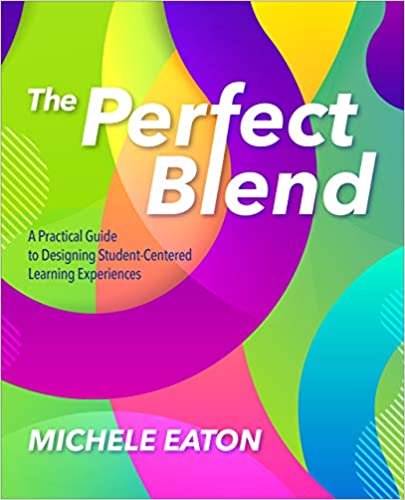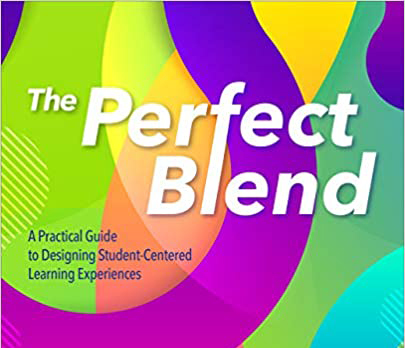**This blog, written by Innovation and Learning Manager, Kara Heichelbech, was originally published on IASP with a feature podcast on the IASP LeaderCast. We know the definition of blended learning is leveraging online learning and face-to-face instruction, but what exactly does that mean? Does using technology in the classroom constitute blended learning? Does the teacher control the use of the technology? If a district is one-to-one does it mean they are using blended learning? Not exactly.  The book, The Perfect Blend: A Practical Guide to Designing Student-Centered Learning Experiences by Michele Eaton (one of Indiana’s own), shares that blended learning “does not mean simply integrating technology into your classroom. For instance, using such collaborative tools as Google Docs or Microsoft One Note, video conferencing with students around the world, and introducing your students to online games to enhance learning are all great examples of integrating technology into the modern classroom, but not of online learning.” (Eaton, 2020). In fact, Eaton goes on to explain that an essential component of blended learning is not only the delivery of the content, instruction and assessment, but also that the students have some control over the learning. Throughout my career as an eCoach, I have seen a lot of really great, technology rich classrooms. Teachers are using great tools and are encouraging collaboration and even active creation, but the teacher typically directs every component of the learning and the tech integration usually lands more on substitution of traditional learning. The lesson has a technology component that creates efficiency or is engaging, but it lacks true student ownership of the learning. A positive to blended learning is the incorporation of student voice and choice. Creating a student-centered learning space can naturally lend to student voice and choice. It can be scary, I know, but I have seen the powerful impact it can have on learning. One of my favorite activities when I was in the classroom centered around student choice, and at times I had 30 students working on 30 different tasks. It could be chaotic at times, for sure, but with some organization, it was worth it for how empowering it was for my students. In her book, Eaton does a really nice job of breaking down student voice and choice into four practical categories: Pace, Path, Time and Place. Spending some time upfront planning for each of these categories can help reduce chaos in the lesson. As you navigate a blended learning approach, here are a few practical tips:
The book, The Perfect Blend: A Practical Guide to Designing Student-Centered Learning Experiences by Michele Eaton (one of Indiana’s own), shares that blended learning “does not mean simply integrating technology into your classroom. For instance, using such collaborative tools as Google Docs or Microsoft One Note, video conferencing with students around the world, and introducing your students to online games to enhance learning are all great examples of integrating technology into the modern classroom, but not of online learning.” (Eaton, 2020). In fact, Eaton goes on to explain that an essential component of blended learning is not only the delivery of the content, instruction and assessment, but also that the students have some control over the learning. Throughout my career as an eCoach, I have seen a lot of really great, technology rich classrooms. Teachers are using great tools and are encouraging collaboration and even active creation, but the teacher typically directs every component of the learning and the tech integration usually lands more on substitution of traditional learning. The lesson has a technology component that creates efficiency or is engaging, but it lacks true student ownership of the learning. A positive to blended learning is the incorporation of student voice and choice. Creating a student-centered learning space can naturally lend to student voice and choice. It can be scary, I know, but I have seen the powerful impact it can have on learning. One of my favorite activities when I was in the classroom centered around student choice, and at times I had 30 students working on 30 different tasks. It could be chaotic at times, for sure, but with some organization, it was worth it for how empowering it was for my students. In her book, Eaton does a really nice job of breaking down student voice and choice into four practical categories: Pace, Path, Time and Place. Spending some time upfront planning for each of these categories can help reduce chaos in the lesson. As you navigate a blended learning approach, here are a few practical tips:
- Leverage your Learning Management System (LMS): An LMS is a very powerful tool to aid in blended learning. However, I most often witness it as a digital file cabinet and turn-in tray. Students watch a video stored on the LMS, complete a worksheet they download from the LMS and turn it to the LMS for grading. Leveraging your LMS to do more can create rich learning experiences for your students. Start with a pre-test and send students on a learning path based on the results. Use the tools in your LMS to create the multiple learning path options with videos, activities, self-reflections, discussions, feedback, and assessments.
- Ensure you tie your assessment to your objective: The assessment does not have to be the same for every student. Going back to my earlier statement of student choice and voice, give students options to not only learn, but also to demonstrate what they know. Maybe one student wants to read about the content, converse with the teacher to clarify points and then write a paper to show an understanding of the material, but another student wants to watch video demonstrations, practice and refine their skill from feedback and then produce an infographic in order to meet the objective. As long as the assessment is tied to the objective, you can see where learning has occurred.
- Remember that instructional design takes time: For the online component of blended learning, it takes time to develop quality lessons, assessments and courses. In fact, Quality Matters, a leader in quality assurance for online instruction, stated in a recent webinar that it takes 100-200 hours to develop a high quality course.
- Explore the various models of blended learning and use one (or blend of a few) that works for you and your classroom: In her book, Eaton describes the seven models the nonprofit Clayton Christensen Institute identified for blended learning:
- Rotation
- Station Rotation
- Lab Rotation
- Individual Rotation
- Flipped Classroom
- Flex
- A La Carte
- Enriched Virtual
- Rotation
These models are a great starting point for blended learning, and Eaton provides practical examples for incorporation throughout her book.
- Fear is natural, but don’t let it stop you: As we embarked on this new journey in education, I have heard over-and-over from teacher friends, “Pretty soon, the technology is going to replace us.” This fear based statement cannot be farther from the truth. We need our teachers now more than ever. Sure, a robotic, canned curriculum where students can easily find answers online that is automatically graded could replace teachers. But that is not the curriculum we want in schools. We want blended learning where our teachers are designing and facilitating rich learning opportunities for students. We want teachers using their expertise and experience creating blended learning classrooms where they integrate technology to enhance their practice, not replace it.
- Start small: We find ourselves on the cusp of revolution in education, and it is scary and exciting at the same time. We cannot change everything overnight, nor should we. Instead, start small. My advice has always been to start with the lesson you like the least or you feel needs improvement. If you already think it needs some love and attention, get the biggest bang and rework it.
It is certainly a new era in education. Embrace the change and find ways to celebrate your growth and achievements. You can purchase The Perfect Blend: A Practical Guide to Designing Student-Centered Learning Experiences by Michele Eaton through ISTE or Amazon.
Resources
Please login or register to claim PGPs.
Alternatively, you may use the PGP Request Form if you prefer to not register an account.



